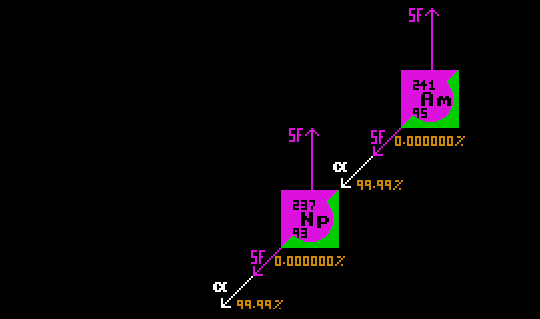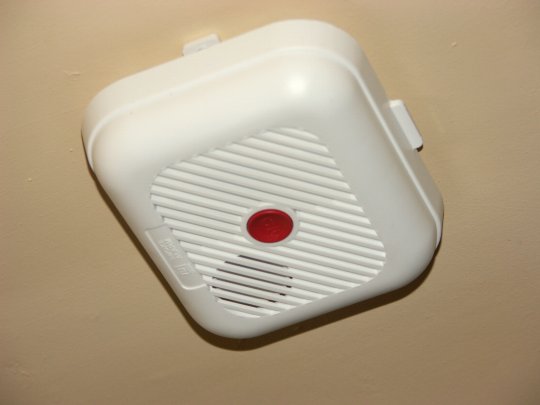
SMOKE ALARMS
The ionisation detector employed in smoke alarms uses a small amount of americium-241 to ionise the air around it and to charge up a capacitor. Particles of smoke from a high temperature fire are also charged, and are attracted to the exposed charged plate of the capacitor, thereby partially discharging it. It is this drop in voltage across the capacitor that is detected by the surrounding electronics which then sounds the alarm. The americium itself is americium dioxide, which is deposited on a gold matrix, which is covered by a thin silver foil, thin enough to allow the alpha particles out. The air itself absorbs alpha rays, so they cannot travel far at all, just far enough to ionize the air in the immediate vicinity. the alpha rays do not have sufficient energy to penetrate human skin beyond the dead layer on the surface.

Ionisation Smoke Alarm mounted on ceiling
Americium-241, an alpha particle emitter with a half-life of 432 years is poisonous on account of its radioactivity, the maximum permissible burden in humans is 30 nano Curies. The alpha activity from americium-241 is three times greater than that from radium, the alpha particles have an energy of 5.36MeV. Americium decays to neptunium-237, another alpha-emitter, but with a halflife many times greater, 2.14x106 years, so this isotope is unlikely to present a radiological problem.
The maximum amount of americium-241 in ionizing smoke alarms is limited to 37 kiloBecquerals (1000 nano Curies, i.e. 33 times the maximum permissible ingestion limit), and the gamma ray dose from such a source is approximately 0.13 nanoSievert per hour (0.0011 milliSievert per year) at a distance of 1 metre. Continuous exposure at this distance gives a dose rate of less than a thousandth that of the average background radiation dose [which some irresponsible people keep bumping up!].
When there is a fire, the fire alarm itself is likely to get melted, but americium-241 will only be disseminated if the silver foil melts, which it does at 960 Celsius. House fires can reach 1200 Celsius. And the plastic casing of the alarm means that the fire alarm is highly unlikely to stay where it was screwed: on the ceiling, it will be more likely to be found on the floor getting battered by other falling debris! Does no-one else think this dangerous? Is the building decontaminated before the occupants are allowed back in? The small amount is likely to be multiplied by about 10, as no-one would have just a single fire alarm, would they? They are more likely to have half a dozen or more, as that is what the instructions say.





![]()
![]()